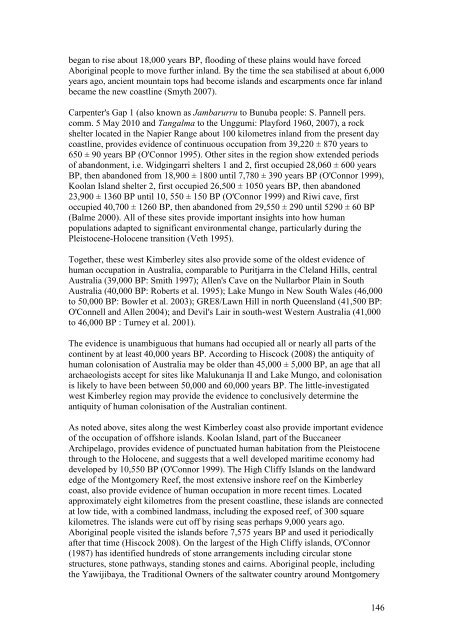WEST KIMBERLEY PLACE REPORT - Department of Sustainability ...
WEST KIMBERLEY PLACE REPORT - Department of Sustainability ...
WEST KIMBERLEY PLACE REPORT - Department of Sustainability ...
You also want an ePaper? Increase the reach of your titles
YUMPU automatically turns print PDFs into web optimized ePapers that Google loves.
egan to rise about 18,000 years BP, flooding <strong>of</strong> these plains would have forced<br />
Aboriginal people to move further inland. By the time the sea stabilised at about 6,000<br />
years ago, ancient mountain tops had become islands and escarpments once far inland<br />
became the new coastline (Smyth 2007).<br />
Carpenter's Gap 1 (also known as Jambarurru to Bunuba people: S. Pannell pers.<br />
comm. 5 May 2010 and Tangalma to the Unggumi: Playford 1960, 2007), a rock<br />
shelter located in the Napier Range about 100 kilometres inland from the present day<br />
coastline, provides evidence <strong>of</strong> continuous occupation from 39,220 ± 870 years to<br />
650 ± 90 years BP (O'Connor 1995). Other sites in the region show extended periods<br />
<strong>of</strong> abandonment, i.e. Widgingarri shelters 1 and 2, first occupied 28,060 ± 600 years<br />
BP, then abandoned from 18,900 ± 1800 until 7,780 ± 390 years BP (O'Connor 1999),<br />
Koolan Island shelter 2, first occupied 26,500 ± 1050 years BP, then abandoned<br />
23,900 ± 1360 BP until 10, 550 ± 150 BP (O'Connor 1999) and Riwi cave, first<br />
occupied 40,700 ± 1260 BP, then abandoned from 29,550 ± 290 until 5290 ± 60 BP<br />
(Balme 2000). All <strong>of</strong> these sites provide important insights into how human<br />
populations adapted to significant environmental change, particularly during the<br />
Pleistocene-Holocene transition (Veth 1995).<br />
Together, these west Kimberley sites also provide some <strong>of</strong> the oldest evidence <strong>of</strong><br />
human occupation in Australia, comparable to Puritjarra in the Cleland Hills, central<br />
Australia (39,000 BP: Smith 1997); Allen's Cave on the Nullarbor Plain in South<br />
Australia (40,000 BP: Roberts et al. 1995); Lake Mungo in New South Wales (46,000<br />
to 50,000 BP: Bowler et al. 2003); GRE8/Lawn Hill in north Queensland (41,500 BP:<br />
O'Connell and Allen 2004); and Devil's Lair in south-west Western Australia (41,000<br />
to 46,000 BP : Turney et al. 2001).<br />
The evidence is unambiguous that humans had occupied all or nearly all parts <strong>of</strong> the<br />
continent by at least 40,000 years BP. According to Hiscock (2008) the antiquity <strong>of</strong><br />
human colonisation <strong>of</strong> Australia may be older than 45,000 ± 5,000 BP, an age that all<br />
archaeologists accept for sites like Malukunanja II and Lake Mungo, and colonisation<br />
is likely to have been between 50,000 and 60,000 years BP. The little-investigated<br />
west Kimberley region may provide the evidence to conclusively determine the<br />
antiquity <strong>of</strong> human colonisation <strong>of</strong> the Australian continent.<br />
As noted above, sites along the west Kimberley coast also provide important evidence<br />
<strong>of</strong> the occupation <strong>of</strong> <strong>of</strong>fshore islands. Koolan Island, part <strong>of</strong> the Buccaneer<br />
Archipelago, provides evidence <strong>of</strong> punctuated human habitation from the Pleistocene<br />
through to the Holocene, and suggests that a well developed maritime economy had<br />
developed by 10,550 BP (O'Connor 1999). The High Cliffy Islands on the landward<br />
edge <strong>of</strong> the Montgomery Reef, the most extensive inshore reef on the Kimberley<br />
coast, also provide evidence <strong>of</strong> human occupation in more recent times. Located<br />
approximately eight kilometres from the present coastline, these islands are connected<br />
at low tide, with a combined landmass, including the exposed reef, <strong>of</strong> 300 square<br />
kilometres. The islands were cut <strong>of</strong>f by rising seas perhaps 9,000 years ago.<br />
Aboriginal people visited the islands before 7,575 years BP and used it periodically<br />
after that time (Hiscock 2008). On the largest <strong>of</strong> the High Cliffy islands, O'Connor<br />
(1987) has identified hundreds <strong>of</strong> stone arrangements including circular stone<br />
structures, stone pathways, standing stones and cairns. Aboriginal people, including<br />
the Yawijibaya, the Traditional Owners <strong>of</strong> the saltwater country around Montgomery<br />
146
















